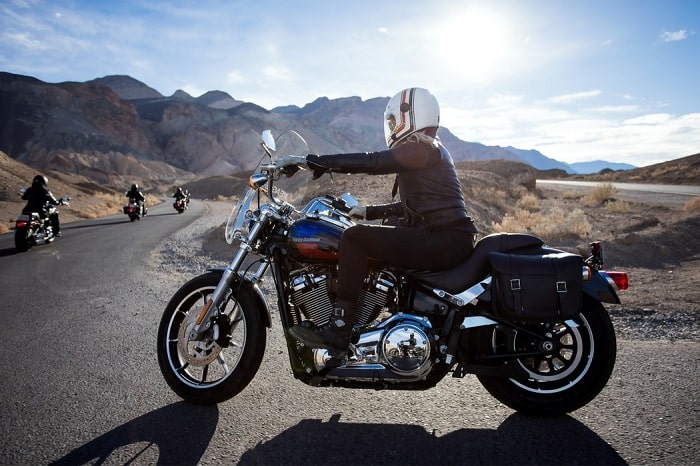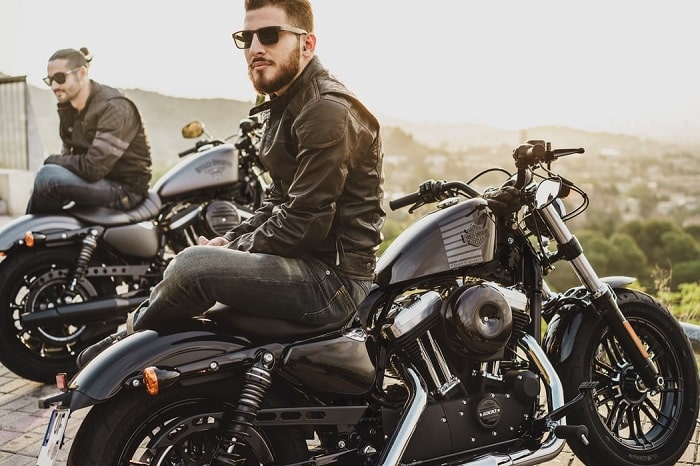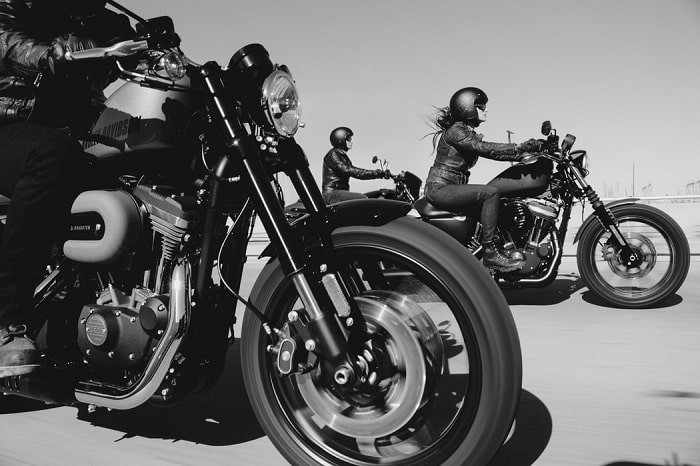You’re on the open road. The sun’s beating down above, but the breeze is keeping you cool. You can feel the power of the engine between your legs. Maybe some leaves have already started to turn with the first hint of fall. It’s a perfect day for a group motorcycle ride.
On such a day (or any day, really), the last thing you want is a motorcycle crash. To ensure that everyone gets home safe, it’s important to take some simple precautions. These are just a couple of safety tips to go over with your group before you pull out into the Fastlane.
Motorcycle Group Riding
Riding your motorcycle with a group can be a lot of fun. There’s nothing quite like the sound of six or seven engines tearing up the highway. That said, for motorcycle safety reasons, you must know how to ride in a group.
Group riding is not the same as riding individually. As a sole biker, you have a lot less to worry about. You are in control of your path, and you only need to consider your position with the other vehicles on the road. In a group, there are many moving parts. Every rider needs to be aware of what is going on around them.
Familiarizing yourself with motorcycle group riding etiquette, riding formation, group riding positions, and group riding rules before you hop on the back of your bike is the best way to ensure that everyone makes it home in one piece.
For that reason, we’ve put together a thorough guide to group riding to go over the basics of group riding and provide you with some handy motorcycle group riding tips.
How to Ride A Motorcycle in A Group
Here is the big question, so we might as well start with the basics. How, exactly, do you ride a motorcycle as part of a group?
Like we mentioned earlier, riding as part of a group is a different game than riding alone. As group riders, you need to operate with the knowledge that you are just one part of a larger unit. Your group will likely move together.
However, each rider is an individual unit within the group, which means that each rider makes their own decisions, and these decisions can impact the entire group. For that reason, communication is key when riding as a group.
When riding as part of a group, riders must plan ahead so that everyone in the group is aware of their router, the group members, and the anticipated length of travel. By planning, riders avoid a lot of unexpected risks.
One of the core aspects of group riding is planning your motorcycle riding formation. Typically, one member of the group is the lead bike or lead rider. This rider will be the first member of the group. The most inexperienced rider generally follows directly behind the lead as the second rider. Another member is the sweep or tail rider and rides at the back of the group. These positions are very important. Each rider should be aware of their motorcycle group riding positions.
Here are some tips for planning a safe group ride:
- Have a pre-ride meeting
- Plan the course
- Select a lead and sweep
- Make a list of group members
- Decide on a formation
- Be prepared for accidents and fuel-ups
- Have a backup plan
- Wear safety gear
When riding in a group, it is important to follow a good group riding protocol to lowers the risk of preventable accidents. If every motorcycle rider in the group rides safely, it greatly reduces the risk of an accident.

Motorcycle Group Riding Protocol
Group riding protocol refers to the generally accepted guidelines for riding as part of a group. When you’re riding as part of a group, it is important to communicate with all riders ahead of time. Communication involves planning, deciding on appropriate responses to an emergency (such as contacting a motorcycle injury attorney in Los Angeles), and selecting a riding formation.
Once you have decided on a formation, including your lead and sweep, it is important to stick to the plan. It is also a good idea to have a backup plan in case a rider needs to leave the group mid-ride, a motorcycle breaks down, or an emergency arises.
Even in the case of an emergency, you will need a riding formation. In the unfortunate case of an accident, your group will need to continue once emergency services have responded. The group might take a short ride to a gas station or truck stop before splitting up to go your own way, or it might be another hundred miles to your destination. If someone is unable to continue, the formation will need to alter.
An important part of safe group riding is riding in a staggered formation. A staggered formation means that riders are not in a “single file.” Instead, riders should position themselves in a line but make sure that the rider in front of them has sufficient room to brake or swerve if necessary.
Riders should form a zigzag pattern, alternating between the left and right sides of the lane so that there is at least one bike length between each motorcyclist and the next. A staggered formation provides all riders with the best possible visibility, the space to stop or slow in case of an accident, and freedom from distractions.
Another important part of group riding protocol is ensuring that overtaking vehicles (passing) lower-level done safely. Safe overtaking means that only one member of the group passes a vehicle at one time. As the first rider passes, the following riders must adjust their position in the formation accordingly. If the gap for safe overtaking passes, riders must make a new, smaller, formation until they have the opportunity to safely regroup.
Other motorcycle group riding tips include:
- Using hand signals
- Being mindful of skill levels
- Taking regular breaks
- Riding at a safe speed
- Dangers of Motorcycle Group Riding

Dangers of Motorcycle Group Riding
Riding a motorcycle will always be somewhat dangerous. However, it is possible to reduce the risk of injury or death by riding with care. As a member of a group, this means following motorcycle group riding etiquette.
Group riding becomes dangerous when riders are not adhering to the conventional motorcycle group riding rules.
For instance, group riding can become dangerous when:
- Riders separate themselves from the group
- Riders of high skill levels do not consider lower-level riders
- Riders spread across the roadway
- Riders have not agreed upon their route
- Riders do not know hand signals
- Riders are unprepared
As you can likely see from the list above, safe group riding relies upon communication, camaraderie, and forethought. When you are riding as part of a group, it is important to know where you plan to go, what route you plan to take to get there, and who will be present on your journey.
A group that is too large can be dangerous. If your group exceeds seven riders, it is generally advised that you break your group into smaller units. These units should all have their own leads and sweeps to avoid the group from becoming disorganized, disorienting, and dangerous. Poor formation planning can put the group at risk of a Rear-End Motorcycle Accident.
The general rule of thumb is that inexperienced riders should not participate in group rides. After completing about 1,000 miles of ride time, riders are assumed to be proficient enough to ride as a member of a group. This guideline allows the rider sufficient time to improve motorcycle riding skills. After 1,000 miles, they are likely to be experienced enough so as not to be a risk to other riders.
Whether you’re touring cross-country or heading out for an afternoon, riding as a group is one of the things that makes motorcycles special. For some people, the camaraderie, friendship, and fun that comes with group riding are what keeps them getting back on their bikes year after year.
Riding as a group can be a difficult task. The different personality of each rider is one of the things that makes group riding special. It is also one of the things that can make it challenging. However, with a little foresight, planning, communication, and adherence to these motorcycle group riding tips, riding as a pack can be fun and fulfilling.
